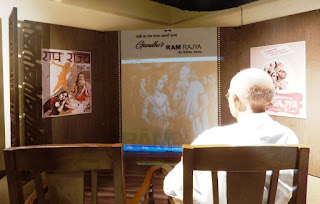A visit to the National Museum of Indian Cinema
Thunder and rain on the outside, and inside hallways of posters upon posters of the most noted films of the Indian film industry, including a silent film wing, detailed literature on the evolution of Indian cinema timelines of regional cinema, models of technical apparatus over decades, cameras, soundboards, lenses, light equipment, praxinoscope all testament to a time when filmmaking spearheaded both technical and creative advancement. This was the day at the National Museum of Indian Cinema in Mumbai, which thanks to Curator Amrit Gangar included amusing, eye-opening stories and anecdotes that I am certain one may not find documented in books but can only know as a result of true passion towards cinema and years of intensive research. Gulshan Mahal an early 19th century bungalow which has a journey of its own has finally become the home for the memories of Indian cinema. Along with this a new building structure sits next to the Mahal. This new establishment had the exhibit that I found most intriguing.
Once you enter the Gandhi and Cinema exhibition hall ( 2019 is the 150th anniversary of both Ba and Bapu. ) you find a sculpture of Mahatma simply seated on a chair watching a film. As noted by Mr. Gangar in an attempt to make this experience interactive, there was previously placed an empty chair next to Gandhiji and one could sit and watch the film with him. What is so interesting about Gandhiji watching a film? As you walk a little further you learn of a certain letter (also part of the exhibit) imploring Mahatma to give cinema a chance. The “evil of cinema“ as the father of the country would put it was also quoted saying :
“Even if I was so minded, I should be unfit to answer your questionnaire, as I have never been to a cinema. But even to an outsider, the evil that it has done and is doing is patent. The good, if it has done any at all, remains to be proved."
Most moving was a letter from writer/director Khwaja Ahmed Abbas in October 1939 issue of Filmindia who called upon Gandhiji to reconsider his opinion of cinema :
“I don’t know even if you have ever cared to see a motion picture. I can only imagine that rushing from one political meeting to another, you chanced to catch a glimpse of some lewd cinema posters that disfigure the city walls and concluded that all the films are evil and that the cinema is a playhouse of the devil."
He points out that an opinion held by Gandhiji can influence an entire nation, it can make or break an industry that is invested in freedom of expression. A special screening was arranged for the Mahatma to view Vijay Bhatt’s film Ram Rajya. The exhibit therefore depicts Gandhiji watching Bhatt’s film “Ram Rajya” based on Valmiki’s Ramayan, an epic the Mahatma admired greatly. … at this time he was 74 and this may well be the only Indian film he ever watched.
Vijay Bhatt later went on to create Prakash Pictures, a film company and Prakash Studios and made 64 feature films including Baiju Bawra (1952), Goonj Uthi Shehnai (1959) and Himalaya Ki God Mein (1965).
Upon my learning of this stark stance of Gandhiji with respect to films Mr. Gangar noted the irony of how Gandhi was indeed the most photographed personality during his time and would later become a subject of many films in the future. Mr. Gangar also spoke about the resistance faced in putting up this exhibit. After all, why at all if he didn’t like cinema? But Mr. Gangar believes in highlighting this important event in the journey of Indian cinema. We cannot just celebrate the victories we must remember the challenges. I am thankful that this section remains and was my favourite of the entire visit. Thank you Mr. Gangar for this incredible museum visit.
Needless to say during this visit I constantly was reminded of the tidbits my father has been sharing with me over the years about Indian cinema, mainly to do with music because that is his area of interest. I am always amazed by his ability to recall not just the composer, singers, film, actors of a song after listening to very little bit of a melody but many stories surrounding the time when the particular song was released.
The National Museum of Indian Cinema has plenty of musically interactive gadgets inviting you to choose and listen to your favorite songs and slip into fantasy.
Here is the title song and credits of Ram Rajya > watch here
If you want to read a good part of the letter addressed to Gandhiji by Khwaja Ahmed Abbas, have a look on Page 25 : read here

Comments
Post a Comment